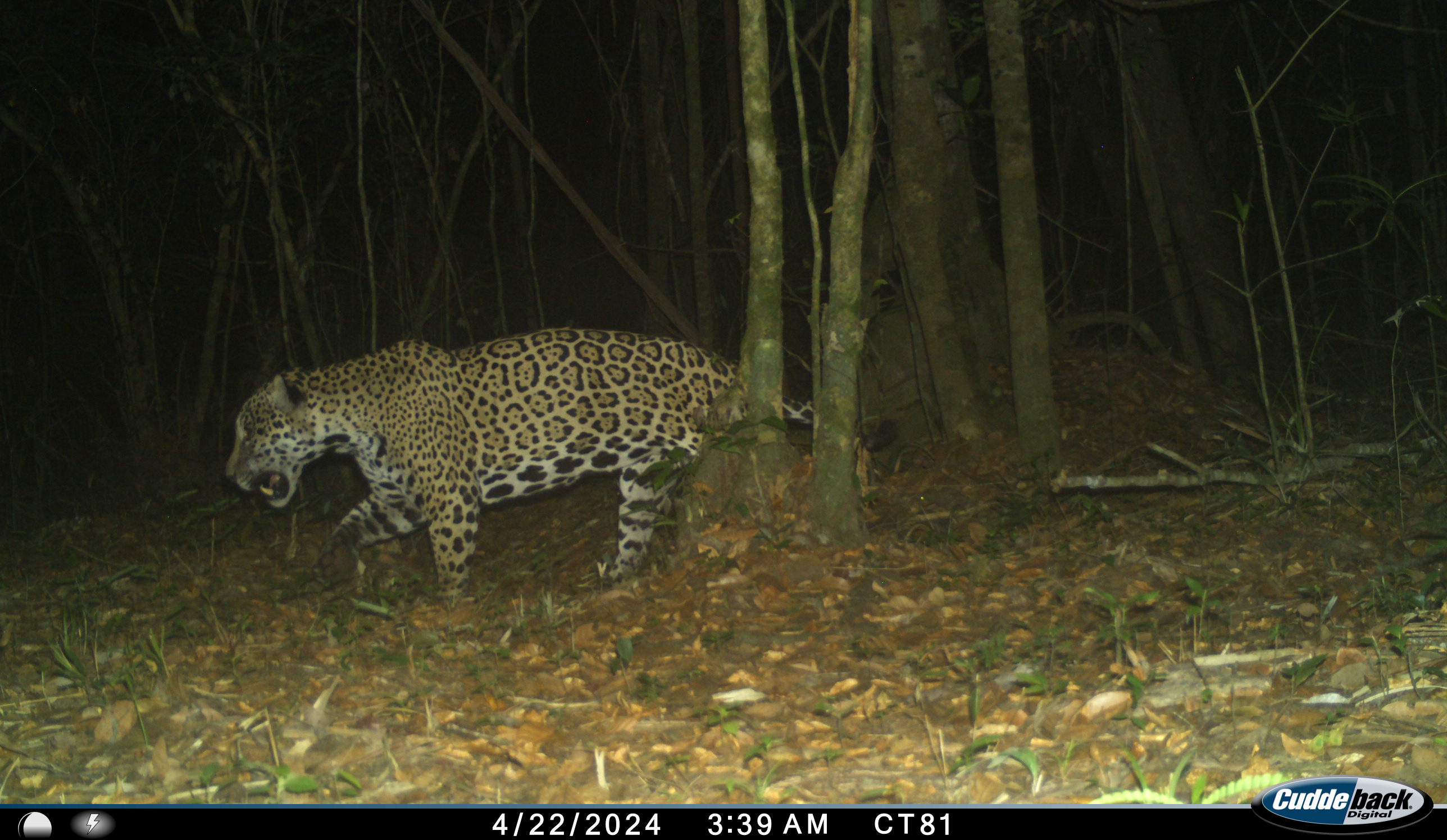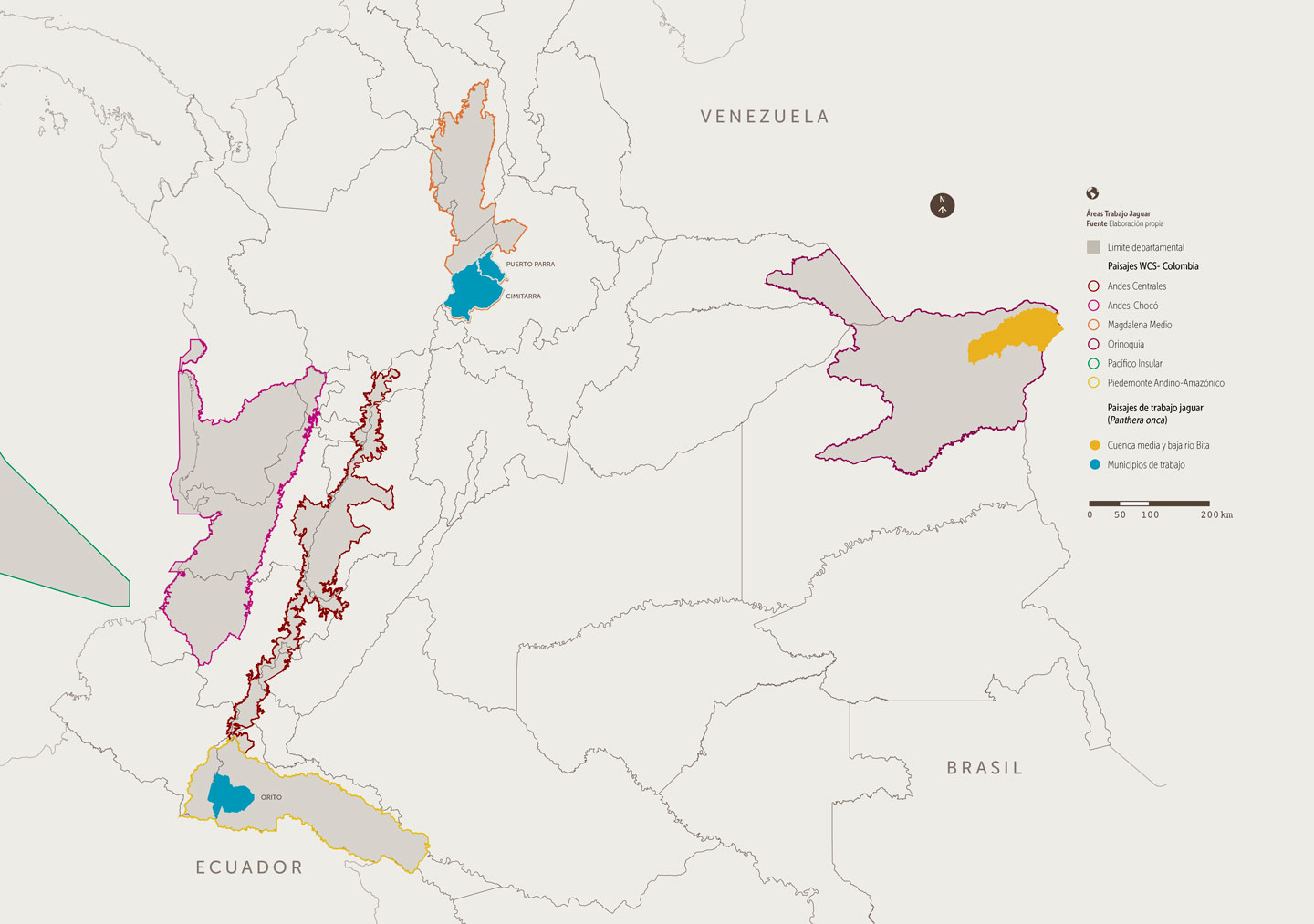Panthera onca
The jaguar is a widely distributed species, ranging from northern Mexico to Argentina. However, its populations have disappeared from over 45 percent of its original range (Rabinowitz and Zeller, 2010). It is typically associated with aquatic environments such as rivers, sandbars, wetlands, and swampy areas (Payán-Garrido and Soto-Vargas, 2012). Although it prefers minimally disturbed environments, there are reports of jaguars near forest plantations—such as African palm plantations—and secondary forests in the Magdalena Medio region (Boron et al., 2016). Its fur is yellow with black rosettes and spots. No two jaguars have identical rosette patterns, not even on both sides of the same animal, a characteristic that is useful for identifying individuals in population studies (Boron et al., 2016). Occasionally, the species shows melanistic variations—individuals with black or dark brown fur—often referred to as "black panthers."
Jaguars are solitary and territorial by nature, although males may share their territory with two or three females. They are active more than half of the time, with peaks of activity at dawn and dusk. The jaguar is a shy animal and tends to avoid humans.
Ecological importance:
Jaguars require large territories to survive and find enough prey. Several studies have shown that large carnivores play a vital role in regulating prey populations and influencing their distribution across the landscape.
In this regard, the jaguar is a keystone species in its ecosystems, helping to increase regional biodiversity by allowing the coexistence of other organisms and removing weaker, older, or sick individuals. Additionally, the presence of this feline in a region indicates the good health of the populations of the organisms it depends on. Moreover, since jaguars have extensive home ranges, protecting them also helps conserve other species and ecological processes. In this sense, large felines serve as umbrella species for natural ecosystems.
Threats:
The jaguar is classified as Near Threatened at the international level (Caso et al., 2008) and as Vulnerable at the national level (Rodríguez et al., 2006; Resolution 0192 of 2014). It has been one of the most persecuted mammals due to its large size and the beauty of its fur (Hoogesteijn and Mondolfi, 1991). Currently, one of the main threats limiting jaguar populations is mortality resulting from hunting, either as retaliation for livestock predation, direct persecution due to fear, accidental encounters, or commercial hunting (Weber and Rabinowitz, 1996; Zeller, 2007). In Colombia, there are believed to be four major population blocks, decreasing in size: the Amazon, Orinoquía, Chocó biogeographic region, and the Caribbean (Payán-Garrido and Soto-Vargas, 2012).
WCS work:
In several Colombian geographic regions, the economy revolves around agricultural activities like livestock farming. These regions still retain much of their natural habitats, which host significant biodiversity. In these cattle-raising areas, jaguars coexist in close proximity to livestock, leading to potential predation incidents. As a result, ranchers may hunt and kill jaguars that threaten their livelihoods. This conflict is one of the species' main threats.

WCS is working in several of these regions: in the Orinoquia, Magdalena Medio, and Putumayo. Surveys have been conducted to understand the extent of impacts and interactions occurring in the landscape, in order to gather baseline information for planning the management of predation. This planning has been carried out jointly with the owners of prioritized properties, to identify the most suitable anti-predation measures tailored to the specific context of each property and landowner. The result is a conservation agreement that includes commitments to promote the coexistence of jaguars and livestock production.

At the same time, camera traps have been used to assess the status of jaguar populations in the Magdalena Medio, Putumayo, and Orinoquia regions. This effort aims to generate baseline data that will help evaluate whether management interventions are having an impact on jaguar populations.
In addition, there is a recognized need to carry out education and awareness-raising activities to improve community perceptions of jaguars and their conservation. These sessions address topics such as jaguar biology, ecology, and the species’ role in maintaining healthy ecosystems.
More than 30 properties in the Orinoquia region have already implemented anti-predation measures and improvements in livestock management. New interventions are planned for the Magdalena Medio (15 properties) and Putumayo (3 properties) regions.
Finally, in Magdalena Medio, an environmental education and awareness program has been launched in collaboration with schools and rural communities to foster a better understanding of the jaguar and its ecological importance.
Translated with AI support